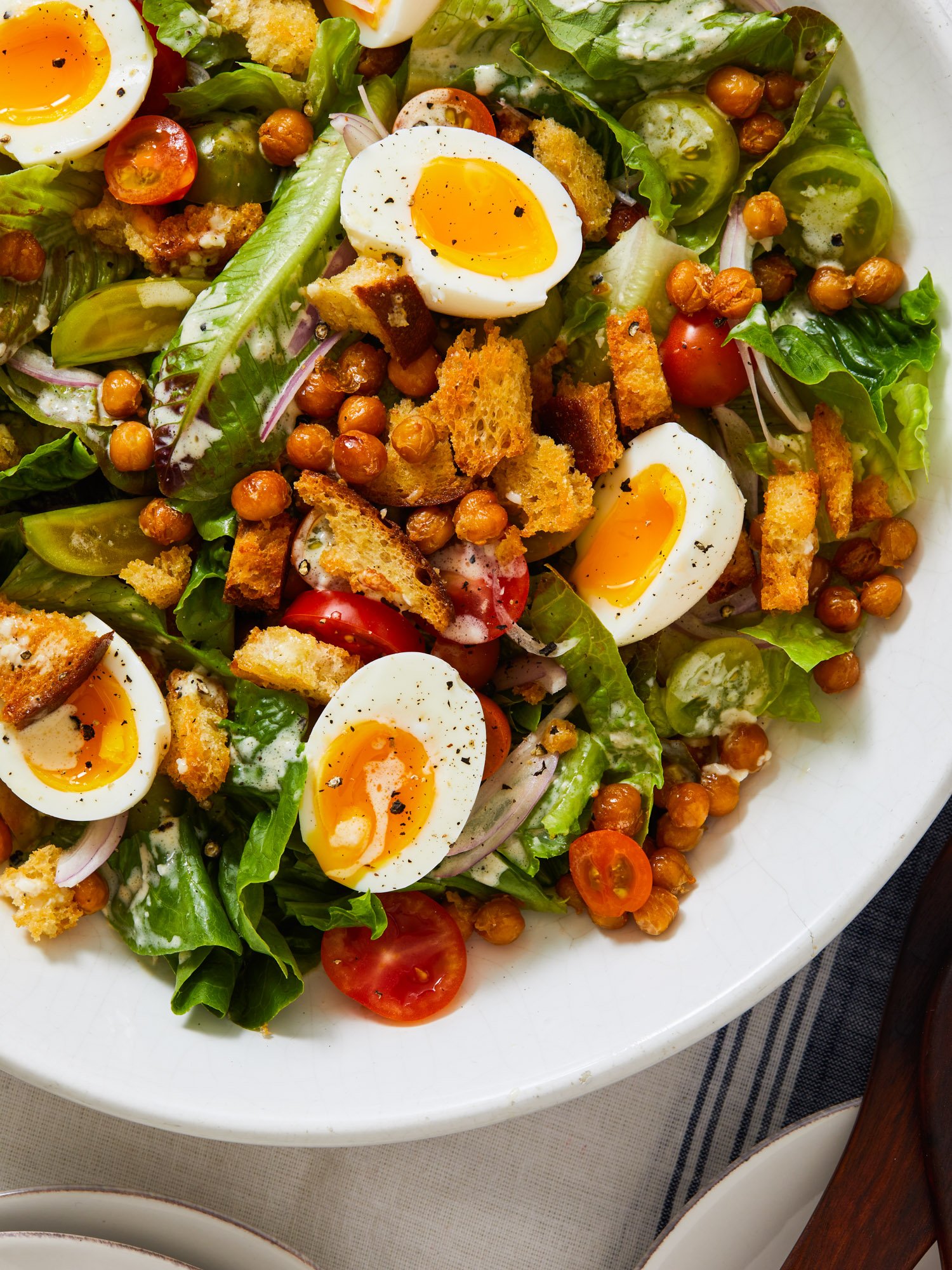5 Ways to Upgrade a Regular Green Salad
Happy June! Happy summer! Happy salads featuring greens that have actual flavor. The only problem? Even when my lettuce is crisp and fresh, I can only eat it with cherry tomatoes and vinaigrette so many times before I start...


Happy June! Happy summer! Happy salads featuring greens that have actual flavor. The only problem? Even when my lettuce is crisp and fresh, I can only eat it with cherry tomatoes and vinaigrette so many times before I start falling asleep at the dinner table. In case anyone else finds themselves in this predicament, I asked a few experts to weigh in on their favorite ways to upgrade basic lettuce-based salads…
But before we even begin to think about what we’re adding to a bowl of lettuce, make sure you first wash and dry that lettuce very thoroughly — salad dressing will not cling to wet leaves. Next, be sure to season and gently toss your greens with kosher or sea salt and freshly ground black pepper — even if there is already salt and pepper in the dressing you plan to use! It’s one of those small steps that makes such a difference in the end product, adding a sparkly brightness to every bite.
1. MAKE YOUR OWN SALAD DRESSING
If this sounds like a lot of work, just think about the return on investment. For under 60 seconds of expended energy, you’ll yield the most delicious dividends in spades. “It sounds obvious,” says Ali Stafford who, among other things, writes a newsletter devoted to farm share produce. “But it’s such a lightbulb moment for people who have not yet ventured into the homemade salad dressing world.”
The How-To: Ali recommends keeping it very simple: 2 parts olive oil to one part vinegar (or more olive oil if you are sensitive to acidity), a little sweetener (honey, sugar, maple syrup), and salt. Once you start making your own dressing, it’s hard to go back. “More and more, I also love a salad dressing that includes both vinegar and some sort of fresh citrus juice,” she says.
2. USE FRESH HERBS
Without herbs, a salad has reached only half its potential. If you’ve ever made an Ottolenghi recipe, you know how important herbs are to his recipes. This is triply (sometimes quadruply, quintuply) the case when it comes to salads. He was the one who taught me how to think of herbs not as a last-minute flourish, but as another whole component of the salad, as crucial to the overall picture as the lettuce leaves themselves, adding a depth that you’ll miss once you get used to them.
The How-To: Don’t overthink it! Toss in any combination of snipped or chopped tender, leafy herbs, such as parsley, dill, cilantro, chives, chervil, basil, oregano, tarragon and mint.
3. ADD TEXTURE
There’s an entire chapter dedicated to crispy things in Jessie Damuck‘s gorgeous book Salad Freak, but I was instantly sold on the way she used fried capers in a green salad, because that way, you’re essentially getting two (texture, pop) for the price of one. “Capers are amazing,” Damuck writes. “Frying makes them even better because it adds a crunch to their saltiness, and they make a simple salad really, really good.” In the salad above, she combines them with fresh lettuce, smooth avocado, and a creamy lemony-yogurt dressing.
The How-To: Heat just less than 1⁄4 inch oil in a small frying pan. Pat 1⁄4 cup capers dry on paper towels — make sure they are very dry before adding to the hot oil, or they will pop and splatter. Fry the capers for about 4 minutes, until beginning to get a little golden and crispy. Transfer to a paper towel–lined plate, and let drain for a minute.
4. CONTRAST TEXTURES
Texture doesn’t have to always mean crunchy. “I like adding components that bring either chewy or creamy,” says Kay Chun, a recipe developer for NYT Cooking. Her secret weapon: Mushrooms, like white button or cremini, “no need to get fancy.” The key, she says, is to dry-roast them. “I cook a batch on Sundays and add to salads all week long — I don’t even chop them!” They bring a chewy texture and meaty flavor, and can take on any vinaigrette beautifully.
The How-To: Spread out on a sheet pan (whole) and roast at 450°F (no oil or seasonings, fight the urge!) until just softened (you’re not going for caramelized and shriveled here), 10 to 15 minutes. They should emerge plump and juicy. Cool and store them in the juices collected from the sheet pan. You can even add the mushroom juices to your vinaigrette.
5. MAKE HOMEMADE CROUTONS
Sure, you can pick them up at the supermarket, but homemade croutons are so easy to make from bread that’s going stale or spoiled. (I’ll bet there’s a loaf like that in your kitchen right now.) I like it when the pieces of bread are artlessly torn — they look more fun and soak up more dressing in their craggy corners.
The How-To: Preheat the oven to 400°F. In a large bowl, toss roughly torn 1-inch bread pieces (any kind, including crusts) with a pinch of garlic powder, salt and just enough olive oil to coat the bread, not drench it. Spread the croutons out on a foil-lined prepared sheet pan and bake until crunchy and golden, 10 to 12 minutes. Or add the oil-soaked bread pieces to a cast iron skillet placed over medium-high heat, cooking and tossing until they are crispy and golden on all sides, about 5 minutes total. For either method, let cool before using.
What are your tricks for upgrading an everyday green salad? Please share.
P.S. Salad for dinner and the only five salad dressings you need.
(Salad with croutons photo by Christine Han. Salad with capers photo by Linda Pugliese for Salad Freak.)
96 COMMENTS

 JimMin
JimMin 

































